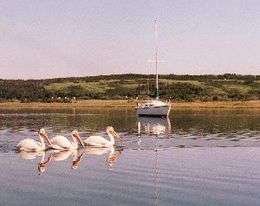Redberry Lake Biosphere Reserve
The Redberry Lake Biosphere Reserve (established 2000) is a UNESCO Biosphere Reserve covering 112,200 hectares (433 sq mi) in the province of Saskatchewan, southwest Canada. The regional landscape is composed of rolling prairie dotted with seasonal ponds and marshes along with aspen/shrub groves. The core area is Redberry Lake, a saline lake with several islands. There are small patches of natural mixed prairie which are very rare in this highly grazed and cultivated part of the prairies.[1]
| Redberry Lake Biosphere Reserve | |
|---|---|
 Redberry Lake | |
 Location in Saskatchewan | |
| Location | Saskatchewan, Canada |
| Nearest city | Saskatoon |
| Coordinates | 52°36′N 107°12′W |
| Area | 112,200 hectares (433 sq mi) |
| Established | 2000 |
| Governing body | Redberry Regional Economic Development Authority Corporation; Rural Municipalities of Redberry, Douglas, Meeting Lake, and Great Bend; Lucky Man First Nations Reserve; and Hanford, Saskatchewan. |
Ecological characteristics
Redberry Lake is a closed basin in which water entering the lake does not pass out through downstream flows. The lake itself is a large kettle hole characterized by a central flat bottom. Gently shelving underwater slopes occur above depths of approximately 25 metres (82 ft). Water is shallowest in the southwest, southeast and northeast areas, and around the islands.[1]
Major habitats and land cover types include: typical prairie grasses such as wheat grass, fescue, oat grass and sedges; forest dominated by aspen with shrubs such as rasp, silver willow and hawthorn; a saline lake with rocky islands; farmland cultivated with wheat and barley; and pasture land. The reserve provides habitats for nine endangered, threatened or rare bird species, as well as over 180 other species including the White-winged Scoter (Melanitta fusca), California gull (Larus californicus), ring-billed gull (Larus delawarensis) and piping plovers (Charadrius melodus). A key research activity undertaken in the area is monitoring of American white pelican (Pelecanus erythrorhynchos) nesting sites.[1]
Socio-economic characteristics
As of 2006, fewer than 1,000 people live in the area most of whom are Euro-Canadians, primarily of Ukrainian origin. The main economic activities in the region are agriculture and livestock raising. Ecotourism development over the past decades has encouraged new ways of looking at local habitats and brought new hope to some community enterprises. The expansion of sustainable tourism activities in tandem with wildlife protection is supported by a vast majority of stakeholders, including representatives of the local communities. The protected status of the site prevents tourism from intruding into fragile areas and allows tourist numbers to be kept at sustainable levels.[1]
New sustainable models of agriculture are being adopted including grazing management in prairies ecosystems and there exists strong potential for the development of new sustainable agriculture, livestock and silviculture products that could be marketed under the biosphere reserve ‘brand’. There is also potential for linkages with other biosphere reserves to market products from sustainable resource use, and to educate the general public about conservation practices.[1]
The reserve is administered by the Redberry Regional Economic Development Authority Corporation; Rural Municipalities of Redberry, Douglas, Meeting Lake, and Great Bend; Lucky Man First Nations Reserve; and Hafford, Saskatchewan.[1]
Area
The reserve's surface area is 112,200 hectares (433 sq mi). The core area is 5,600 hectares (22 sq mi), surrounded by buffer zone(s) of 6,300 hectares (24 sq mi) and transition area(s) of 100,300 hectares (387 sq mi).[1]
Sources
![]()